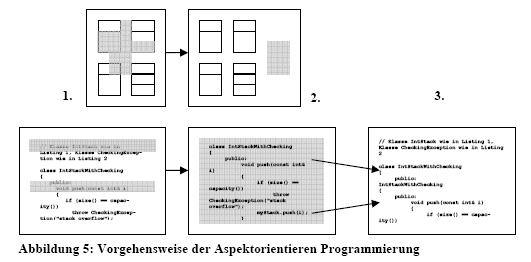
3 configuration options of software
Fast development cycles by frequently changing requirements require flexible software architectures.
Here that sets 1997 published paradigm of aspect-oriented programming. In addition, this is to extend object-oriented programming,
becomes as independent Paradigma92 of which COM, CORBA or draft sample uses, understood.
Main idea of aspect-oriented programming is complete those realization of the Separation of Concerns, which is technical separation
of important aspects or parts in programming, because many functionalities in object-oriented programming distributed on various classes,
CROSS Cutting Concerns so mentioned. In addition aspect-oriented programming offers methods and techniques, in order to differentiate
functional components and aspects orthogonal for program semantics to lead back and these again into a total composition.
The reusability of the parts is the center of attention thereby.
Aspects embody here
the code fragments of functions, scattered over the classes, which affect the software system in various places.
Examples for this are right examinations, persistence, synchronisation of data, object interactions and parameter transfers.
They embody on the one hand the requirements and encase them at the same time as program constructor93.
They can contain attributes, Kostanten, member types and functions, or
replace and call also algorithm parts later. The aspects are paged out in own classes or other language fragments. Interconnect points,
so-called Join POINTs, connect them with the remainder of the program. A Weaver controls, which classes are to be addressed by which
aspects and ""she weaves among themselves.
The advantage of aspect orientation is
in the fact that aspects can be in-maintained to extend also after compiling in component architectures, since aspect-oriented programming helps the crucial program sections the Concerns, to recognize and again use. In addition (see illustration 5)
94 must

| Evaluation of the aspect-oriented Programming95 |
| Advantages | Disadvantages |
| Top| Home| << back | next >> >> Home Page www.outsourcingintelligence.com << |